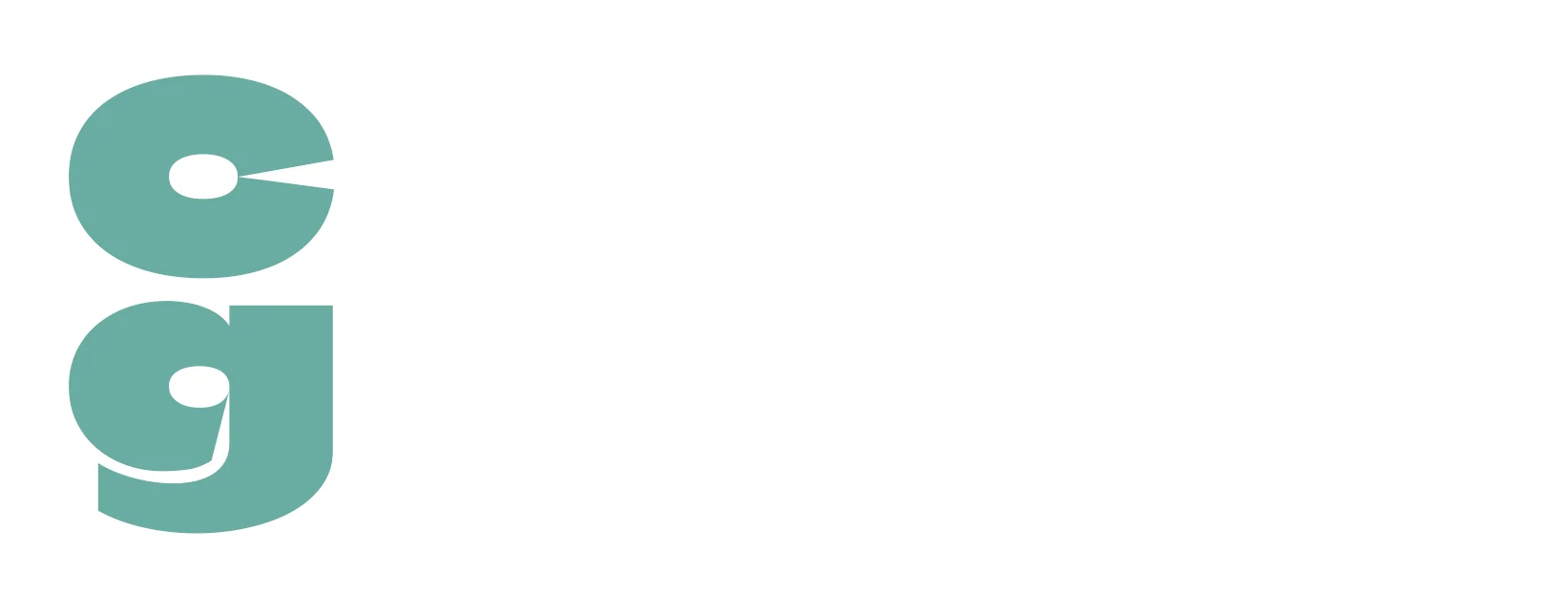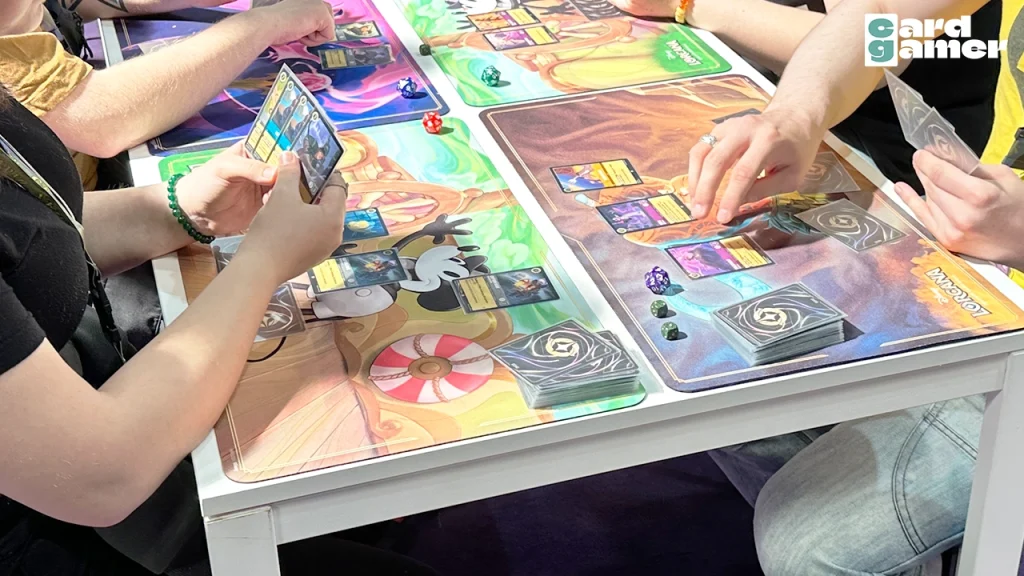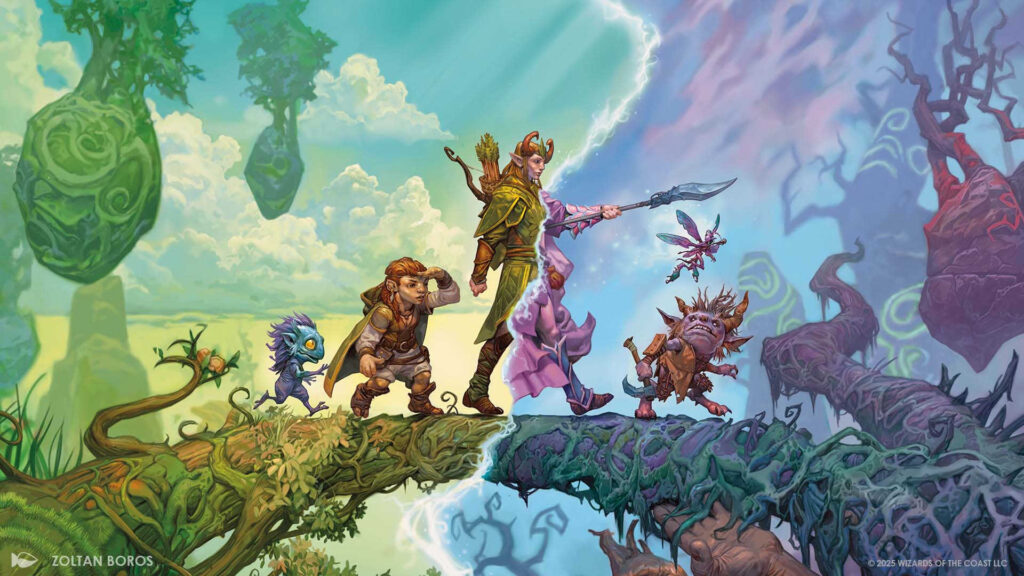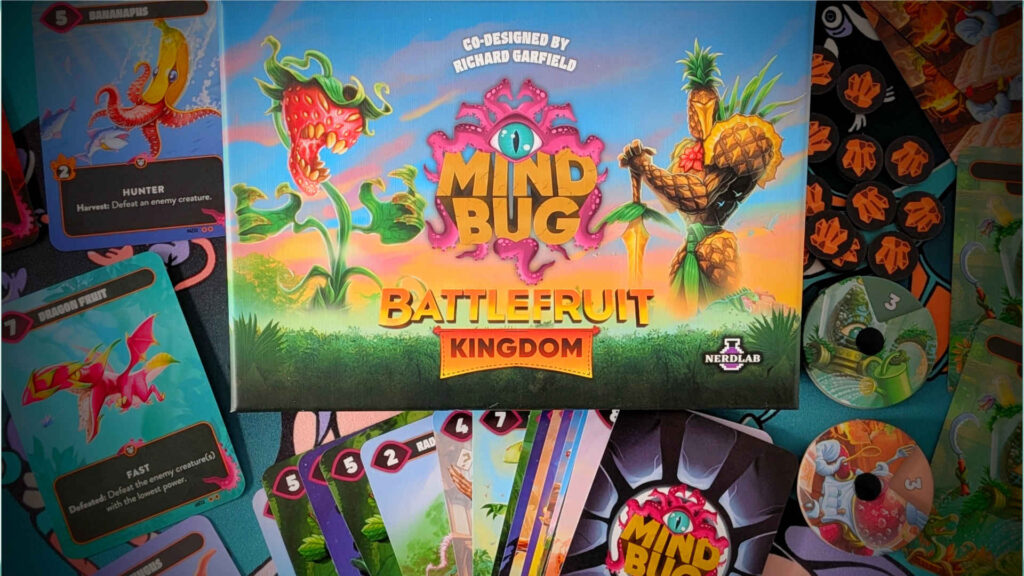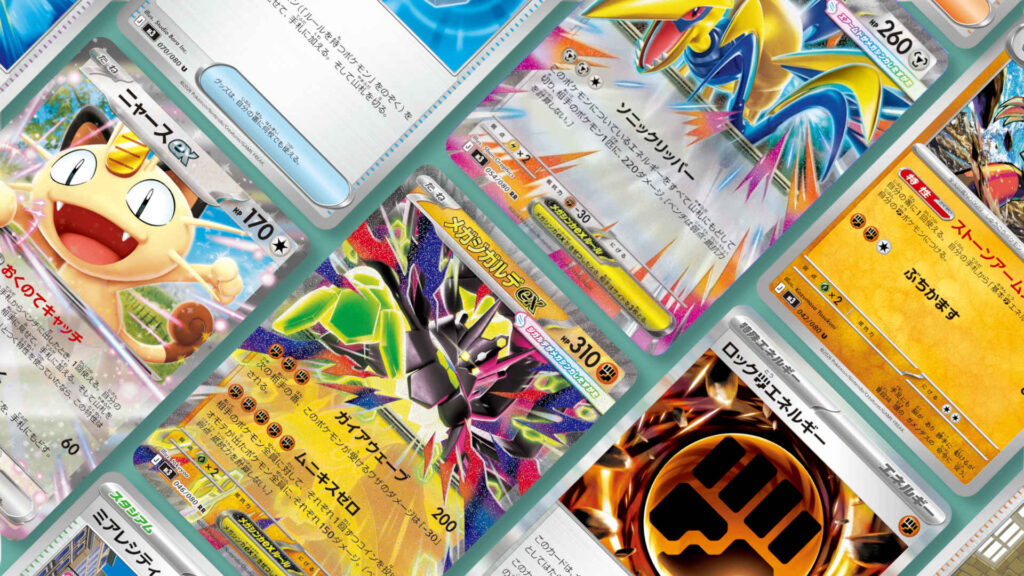Disney Lorcana is releasing soon! It’s the first time that Disney has taken a serious foray into the Trading Card Game world, and with it comes a lot of expectations. People are wondering about the value of cards, the best decks that you can play, and how to actually play the game. Luckily, we’ve got the full description of what each kind of card does, what you need to know, and what you should understand before you go off and buy a ton of cards to play the Disney Lorcana TCG game.
We’ll be running through how to read a Disney Lorcana card, how you build your Disney Lorcana deck, how to take action during your turn, and how you actually win a Disney Lorcana game.
Table of Contents
ToggleHow To Read A Disney Lorcana Card
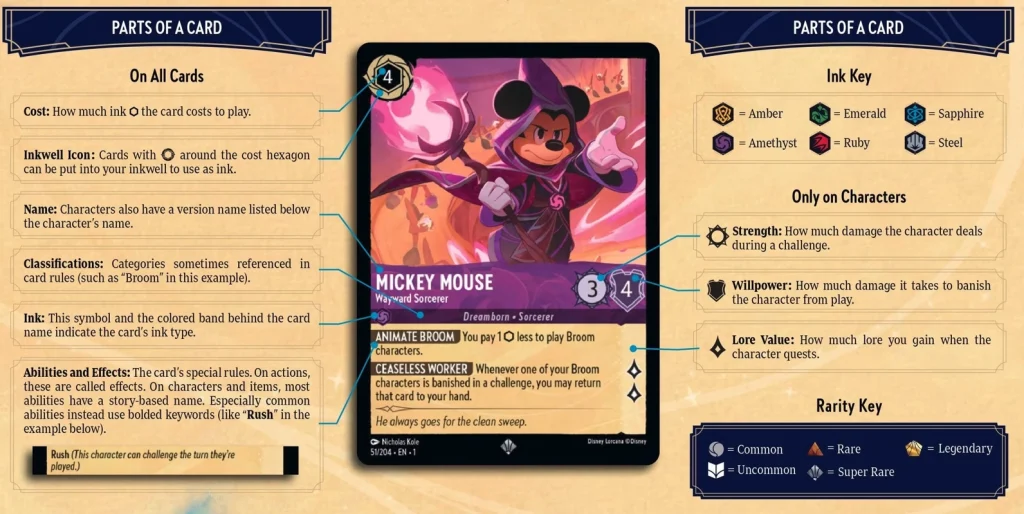
There are a few things that you need to know about a Disney Lorcana card before you get into the weeds with the game.
What Is Ink In Disney Lorcana?

Ink is what’s used to pay to bring cards into play in Disney Lorcana; there’s a number in the top left corner of each playable card that will tell you what the card costs, which we’ve circled for you above.
If the number has the Ink symbol around it, this means that you can place the card face down into your ‘Inkwell’ (which is a resource row, below the cards you’ll have in play) to be used as ink. This is known as the Inkwell icon; if a card doesn’t have that and is instead just the number in a hexagon, it cannot be placed face down in your Inkwell as a resource.
The Card Name
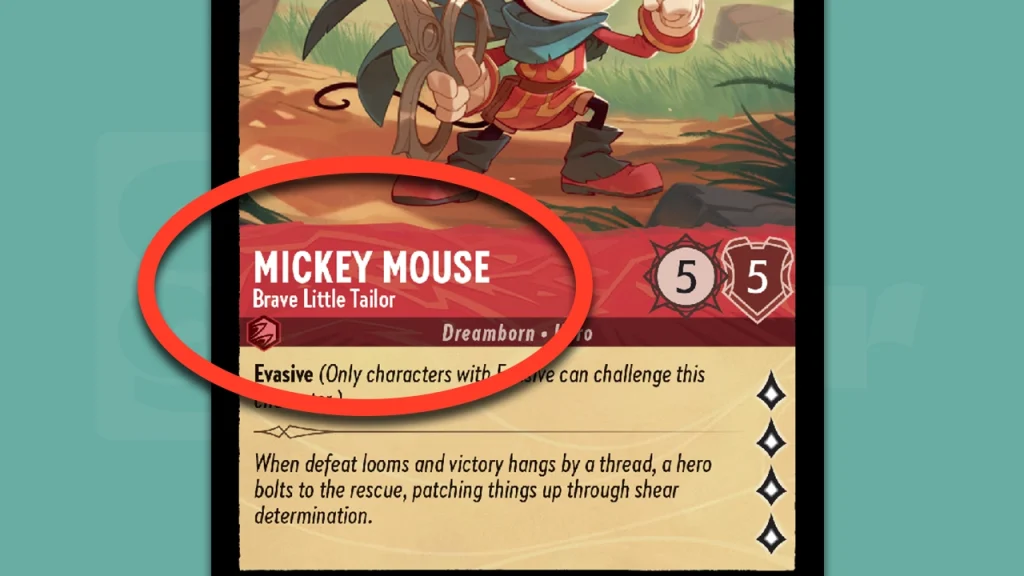
As you can see, circled in the image above is the name of the card. You can have up to four copies of the same card in your deck; for example, you may have four copies of the Mickey Mouse, Brave Little Tailor card; note that if you have any other Mickey Mouse cards that aren’t Brave Little Tailor, you can have up to four copies of each of those too, as long as the name is distinct.
Strength and Willpower
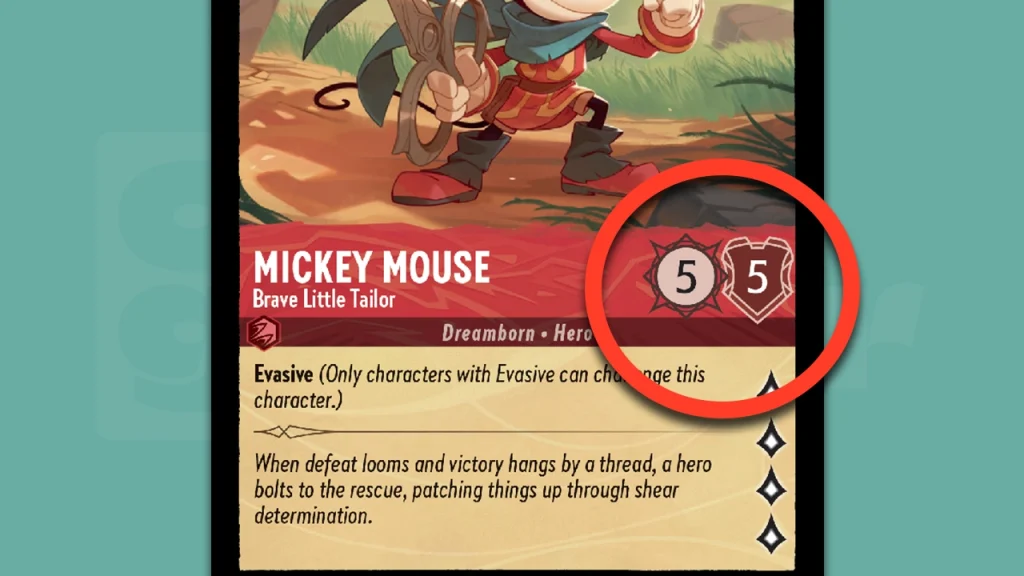
Directly next to the name of the card, you’ll see two different numbers. The first number is the character’s Strength, and this is shows how much damage the character deals during a Challenge, which is Lorcana’s main method of ‘combat’.
To the right of the Strength number, within the Shield symbol, is the character’s Willpower. This denotes how much damage the character can take before it is removed from the play area (or ‘banished’, to use the in-game terminology).
Classifications
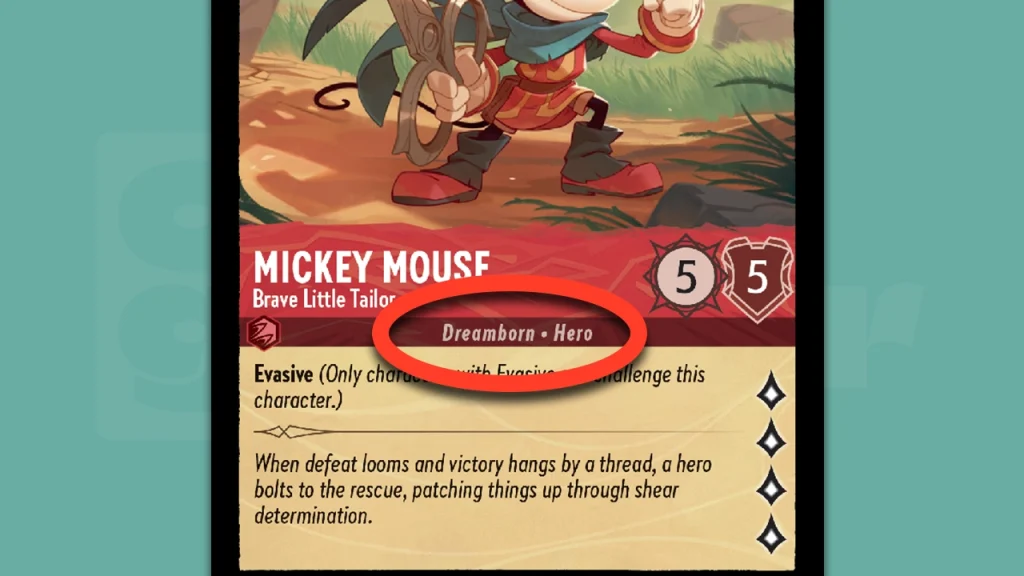
Classifications specify exactly what type of card you have. Basically, it describes classes and types of actions. Characters will fit into one type of ‘-born’ classification: Storyborn, Dreamborn or Floodborn. You can check out what these terms mean in our guide here.
Though they don’t always have a huge impact on the game, some card effects and abilities may refer to a specific classification, so for example referencing Hero characters, or Dreamborn; also, it’s worth noting that Floodborn characters have the ‘Shift’ keyword, which allows you to ‘evolve’ a Storyborn or Dreamborn character into a more powerful Floodborn version, for a reduced cost.
Ink Type
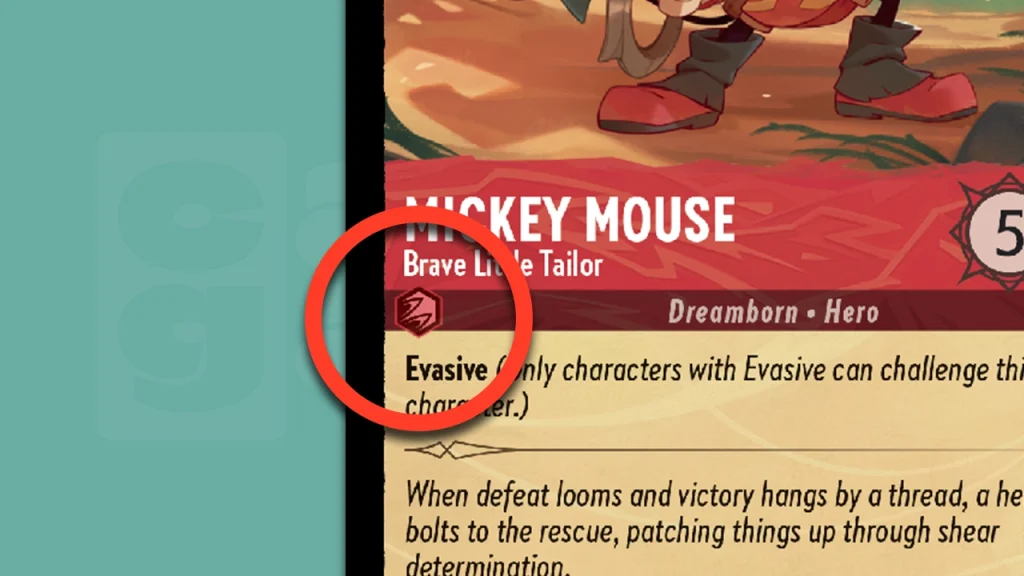
There are two ways to work out what Ink type a card is; the most obvious is just to see what colour the card’s frame, outside of the illustration, is. In the case of the Mickey Mouse, Brave Little Tailor card, you can see that it has a red frame below the illustration; this means it’s a Ruby Ink type card. Each Ink type (there are six: Ruby, Sapphire, Emerald, Amber, Steel and Amethyst) has its own symbol, and we’ve circled the Ruby symbol for you above.
One thing that’s worth noting is that, if you’re building your own deck from cards in your collection, you can use up to two different types of Ink; using three or more Ink types is not permitted.
Abilities
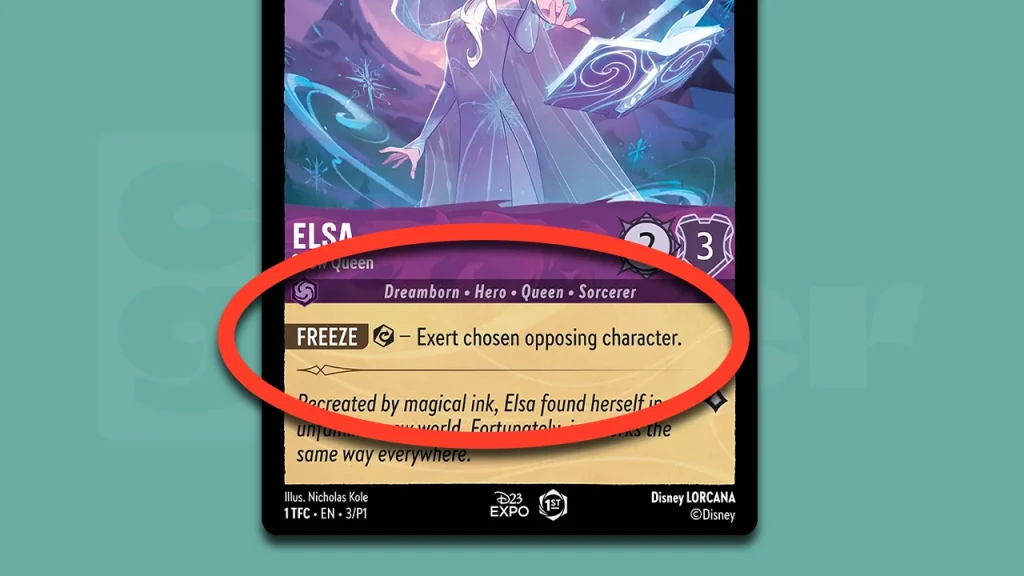
Ability text shows the different things that the card can do. These are either triggered by other actions or effects that occur on your turn. Some words are ‘keyworded’ meaning that they do specific things repeatedly. For example, the Elsa, Snow Queen card above has the ‘Freeze’ ability; you may exert (turn sideways) the Elsa card in order to exert a chosen opposing character.
Lore
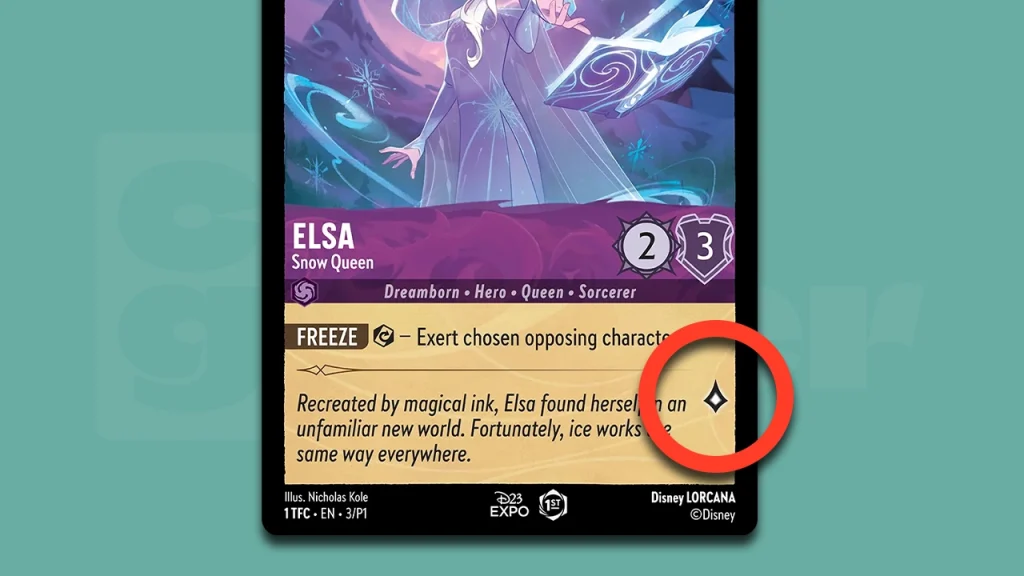
Circled above is the Lore symbol; Lore points are generated by ‘Questing’, and the number of symbols on a card shows how many points of Lore are gathered by a specific card. You’ll need to gather 20 points of Lore to win a game of Disney Lorcana, so this symbol is very important!
Set Information
In the bottom left hand side of the card is the artist’s name, the number of the card and the set code. These have no impact on the game at all, being there for collectors and for specific card information if you’re perhaps trying to find out what gaps you have in your card collection!
What are the Disney Lorcana Rarities?
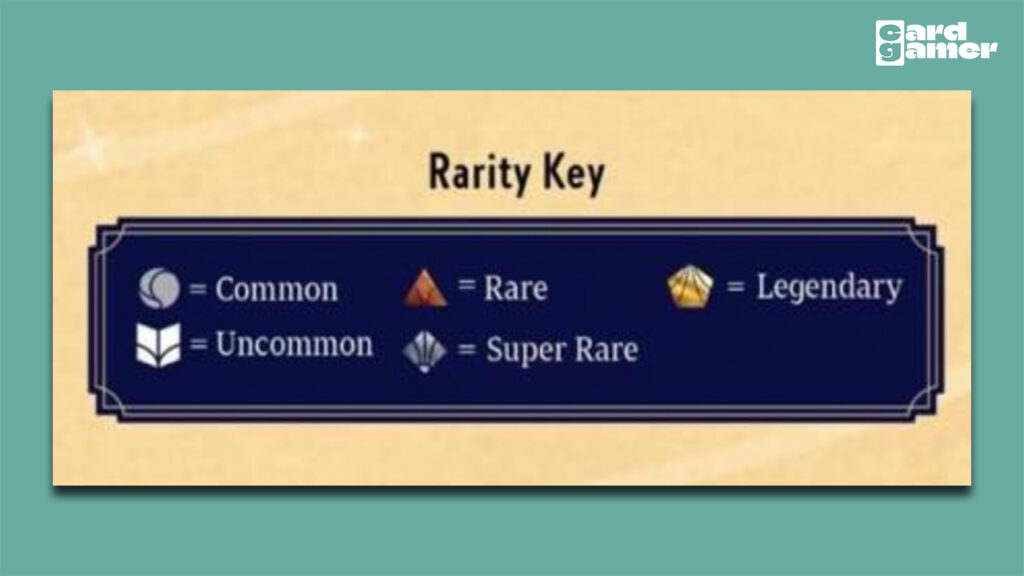
There are five standard card rarities in Lorcana, as shown above:
- Grey: Common
- White: Uncommon
- Bronze: Rare
- Silver: Super Rare
- Golden: Legendary
Finally, there’s also a Rainbow symbol, which denotes that a card is at the ‘Enchanted’ rarity level. Check out our Disney Lorcana TCG Rarity Explained article for further details, and our guide to Lorcana pull rates, which will give you an idea of just how often (or not!) you can expect to see certain cards in your booster packs.
Building Or Using Your Own Deck In Disney Lorcana
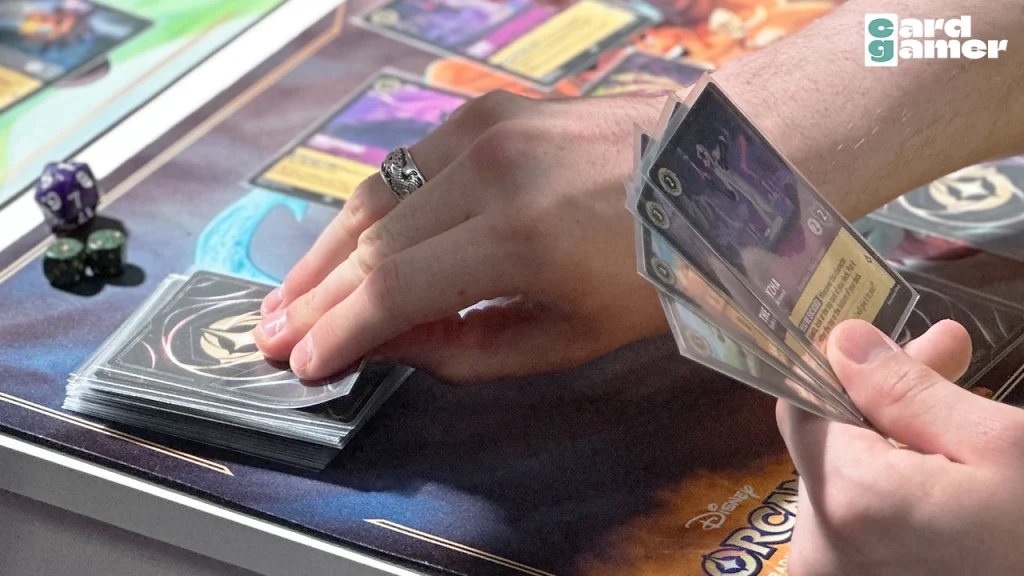
Your deck needs to be at least sixty cards, which can include up to four copies of any identically named card. Though you can have more than sixty cards, we’d advise against it; the more cards you have, the less chance you have of drawing specific cards during play.
There are different types of cards: Characters, Items, Actions, Songs and Locations. Characters are used to challenge your opponent and gather Lore.
Actions have a one-time effect, that you’ll enact and then place the card in your discard pile. Items can remain in play until removed by a card effect or other character’s ability. Songs are an action which have requirements that can be skipped, according to the text on the card or a character you have in play. Locations were introduced in the Into the Inklands set, and these can generate Lore, as well as have Characters attached to them for other bonuses. Check out how to use them here.
It’s very important to remember, you can only have two different Ink types in your deck. There are six Inks to choose from, all of which have their own specialities:
- Amber (Yellow): A defensive Ink.
- Amethyst (Purple): Cards that use abilities and actions to enforce a control strategy
- Emerald (Green): An adaptive Ink that can take cards back from certain zones
- Ruby (Red): The aggressive Ink, which is known to deal direct damage to your opponent much more efficiently.
- Sapphire (Blue): An Ink type that uses item cards a lot.
- Steel (Grey): Cards with high defence and the ability to use brute force.
How To Win The Game
There are two different ways to win a game of Disney Lorcana. The first way is to collect 20 Lore before your opponents, usually by Questing with your characters. The other way is to ensure that your opponent has no cards in their deck when they are required to draw a card at any point; when this happens, you immediately win the game.
Starting The Game
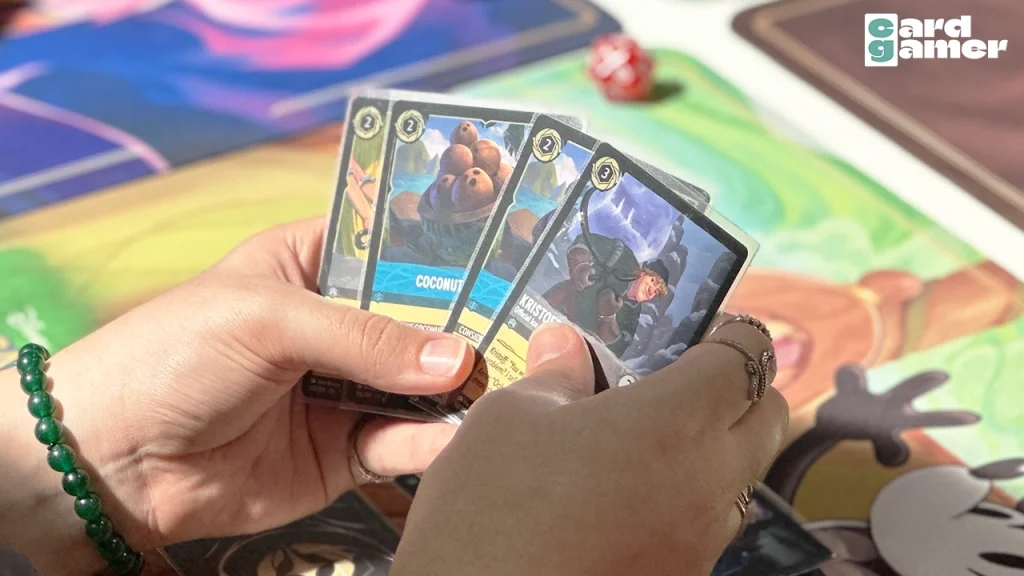
To start a game, shuffle your deck and draw seven cards. During the first game, you have to keep that opening selection of seven cards. However, if this isn’t the first game, then you can alter your hand by putting as many cards as you want onto the bottom of the deck and then drawing that amount. You can only do this once, however. Next, play rock-paper-scissors to decide who goes first.
Turn Phases
There are two phases to a turn in Disney Lorcana. There’s the ‘Beginning Phase’ and the ‘Main Phase’.
The beginning phase has three parts:
- Ready: Turn any exerted cards 90 degrees into their usual position
- Set: Any abilities that trigger at the start of your turn are resolved.
- Draw: Draw the top card of your deck. If it’s the first turn, you don’t draw for your turn.
The Main Phase
The main phase is where you do all of your actions. In your main phase, you can do any of the following things before ending your turn.
- Reveal a card and put it in your inkwell (face-down)
- Play any character, item, or action card as long as you can pay their ink cost
- Use your character or item abilities. Important to note that if an ability needs a certain character, then you have to have had the character in play since the start of the turn.
- Have one of your characters go on a quest for Lore
- Challenge your opponent’s characters
How To Play Cards & Make Ink
As previously mentioned, you have to pay a certain amount of Ink specified on a card to actually use it. To turn cards into Ink, you reveal a card with the circular Inkwell symbol and place it face-down into your inkwell.
Your Inkwell cards can be used to make one Ink, which then can pay for any other card that requires Ink. For example, you must exert three Ink cards to play any card that costs three Ink to actually play. All of your Ink is reset at the start of your turn, but those cards cannot be challenged by your opponent when they are exerted.
Questing With A Card
Questing is how you generate Lore. It’s an action that you have to take during your main phase, and requires you to exert a character card. Basically, the previously mentioned Lore value on the right side of your card is how much lore it generates when you choose to quest.
It’s important to remember though that you can only exert a card once a turn. A card can either quest, challenge, or use an ability that needs exertion, but only one of the three. If a card exerts, then that makes that card open to being challenged.
What is Challenging?
Challenging is the Disney Lorcana version of combat. You can only challenge during your own main phase, and characters can only challenge based on two conditions. These two conditions are as follows:
- The character you want to challenge is currently exerting
- Your character has been out since the start of the current turn
By challenging a character that has been exerted you need to exert your own character. At that point, both characters in the challenge deal damage to each other equal to whatever their Strength is. If a character takes more damage than their Willpower, then they are banished and go straight to the discard pile.
Damage doesn’t go away from cards, meaning you will need to use tokens to keep track of who has taken damage. Cardboard tokens are included with Lorcana Starter Decks, but you can also use fancier ones if you prefer, such as the custom tokens we tested for this guide. Note that you can only challenge with a card once per turn (unless a card ability or action effect changes that), but you can challenge with multiple different characters in the same turn if you want to go all-out against your opponent.
Though of course there are exceptions and extra rules that’ll pop up over the course of a game of Lorcana, those are the basics that will get you started as quickly as possible. Of course, new mechanics, card types and abilities are being added as more sets are released, but the main thing that Ravensburger are continuing to ensure is that the game remains pretty simple, easy to understand, and playable by gamers of any age or experience level.
